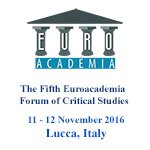Euroacademia Conferences
 Europe Inside-Out: Europe and Europeanness Exposed to Plural Observers (9th Edition) April 24 - 25, 2020
Europe Inside-Out: Europe and Europeanness Exposed to Plural Observers (9th Edition) April 24 - 25, 2020 Identities and Identifications: Politicized Uses of Collective Identities (9th Edition) June 12 - 13, 2020
Identities and Identifications: Politicized Uses of Collective Identities (9th Edition) June 12 - 13, 2020 8th Forum of Critical Studies: Asking Big Questions Again January 24 - 25, 2020
8th Forum of Critical Studies: Asking Big Questions Again January 24 - 25, 2020 Re-Inventing Eastern Europe (7th Edition) December 13 - 14, 2019
Re-Inventing Eastern Europe (7th Edition) December 13 - 14, 2019 The European Union and the Politicization of Europe (8th Edition) October 25 - 26, 2019
The European Union and the Politicization of Europe (8th Edition) October 25 - 26, 2019 Identities and Identifications: Politicized Uses of Collective Identities (8th Edition) June 28 - 29, 2019
Identities and Identifications: Politicized Uses of Collective Identities (8th Edition) June 28 - 29, 2019 The European Union and the Politicization of Europe (7th Edition) January 25 - 26, 2019
The European Union and the Politicization of Europe (7th Edition) January 25 - 26, 2019 7th Forum of Critical Studies: Asking Big Questions Again November 23 - 24, 2018
7th Forum of Critical Studies: Asking Big Questions Again November 23 - 24, 2018 Europe Inside-Out: Europe and Europeanness Exposed to Plural Observers (8th Edition) September 28 - 30, 2018
Europe Inside-Out: Europe and Europeanness Exposed to Plural Observers (8th Edition) September 28 - 30, 2018 Identities and Identifications: Politicized Uses of Collective Identities (7th Edition) June 14 - 15, 2018
Identities and Identifications: Politicized Uses of Collective Identities (7th Edition) June 14 - 15, 2018
Cultural Identity in the Informal Portraits of the Qing Emperors
-
-

-
Presentation speakers
- Youngmin Kim, Seoul National University, South Korea
Abstract:
An identity crisis is bound to occur when a political community finds that what it had once unquestionably accepted as the definitions of its collective self are no longer acceptable under new historic conditions.The rise of Qing China (1616-1911) posed exactly such a challenge. Indeed, the Qing was radically different from the previous dynasties in that it represented a much more extensive empire which possess a wide variety of peoples. To make sense of the complex cultural identity of the Qing, one needs to turn to informal portraits rather than public statements and formal court portraits. As I hope to show, the informal portraits of the Qing emperors reveal the cultural identity of Qing China in a way different than in earlier dynasties. To analyze which strategies are used to construct the complex cultural identity visually, this paper focuses on the Qianlong emperor’s informal imperial portrait known as One or Two and an album of fourteen leaves portraying the Yongzheng emperor. In the paintings, the emperors constantly change dresses and assume different nationalities and roles. They appear as a Persian warrior, Turkish prince, Daoist magician, Tibetan Monk, Mongol nobleman, and many more including one in a European wig, vest and breeches. Taken together, the informal imperial portraits suggest that the ruler should not be committed to any of the moral, cultural, or ethnic outlook. At the same time, they embody the theories and strategies that made the Qing rulers come to terms with a wide range of different constituencies without letting the empire fall apart.This type of visual narrative helps us ask better questions about what people were doing when they were forging their cultural identities.
-
Related Presentations

Institutionalised Identity
- Karolina Golinowska

European Cities and New Inhabitants: A Heritage Contribution by Migrants
- Stefania Scarsini

The Ontological and Metaphysical Aspects of the World Coordinate System Based on the Limits of Dynamic Equilibrium
- Kozhevnikov Nikolay
- Danilova Vera













